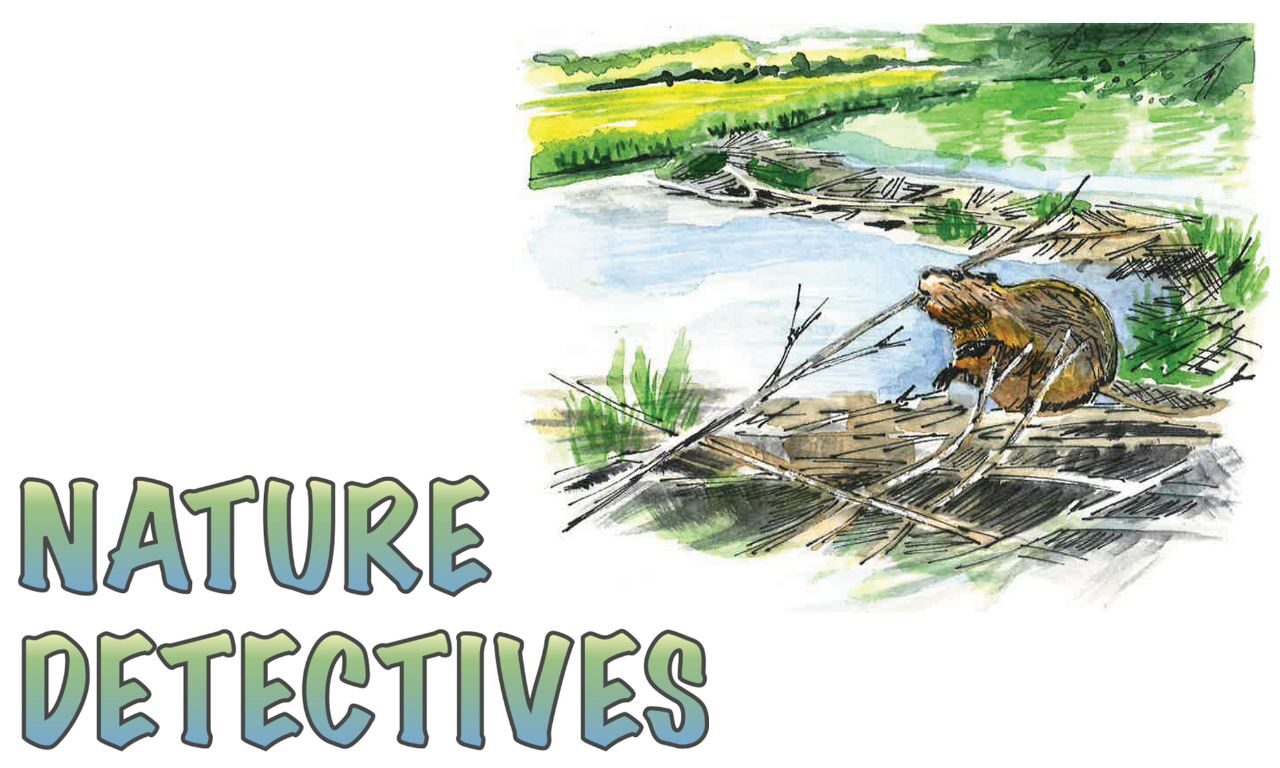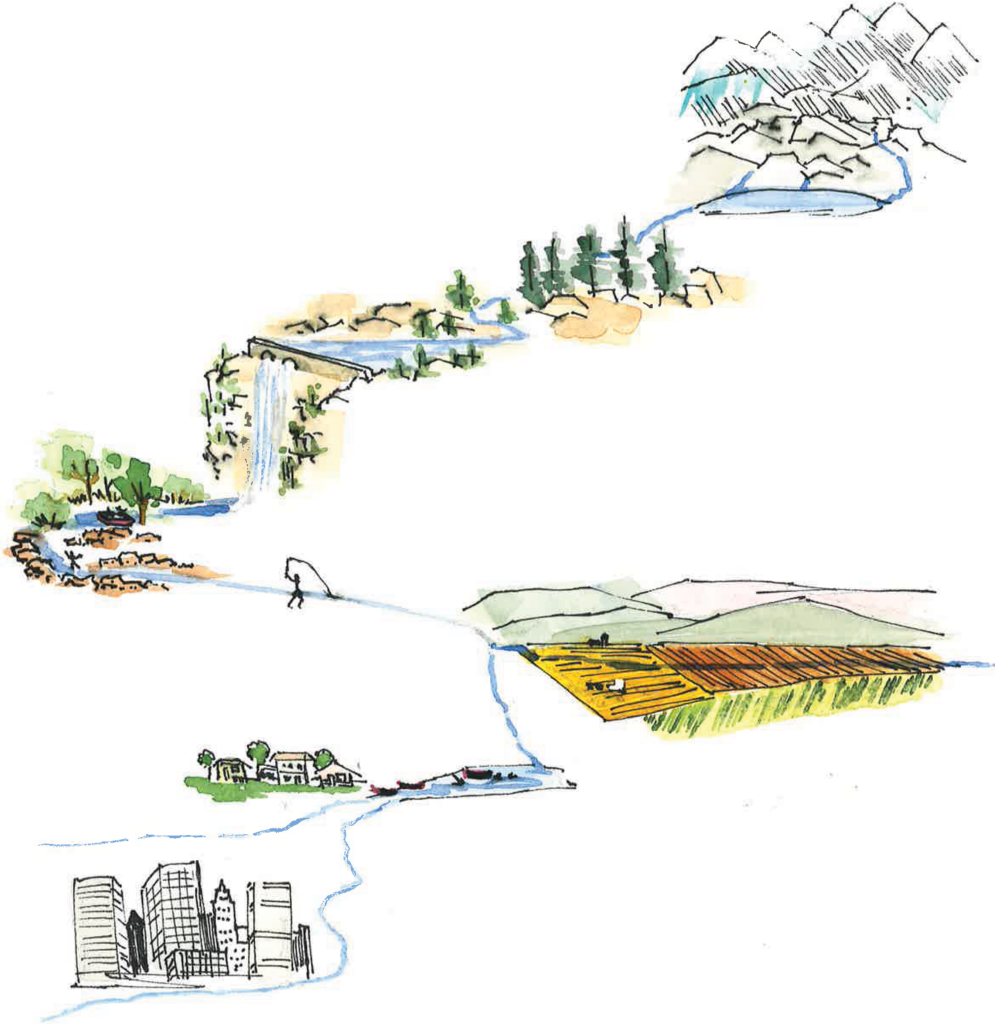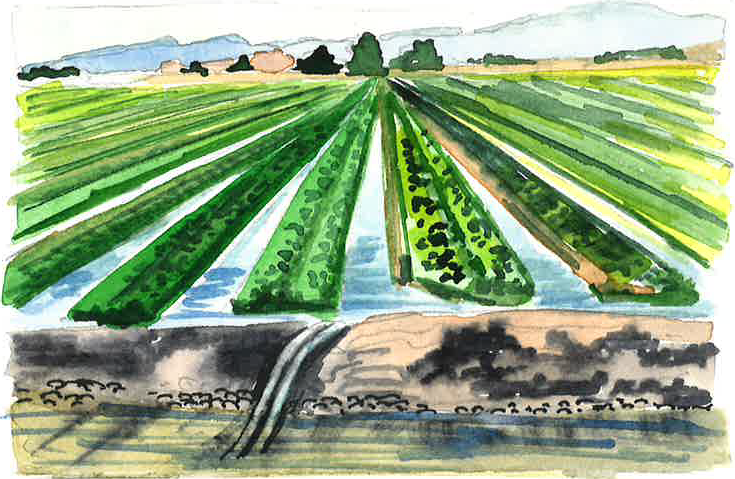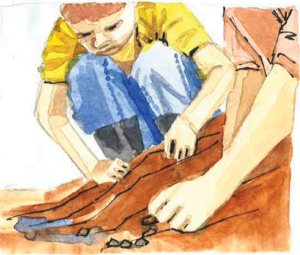Can you answer this stumper question? Where do you live?
Hint: The answer is not your home address, but it is the same answer for everyone on earth, even though we live in different places.
Hint: The answer is not “planet earth.”
Hint: The answer has to do with water.
Answer: You, I, and everyone else live in a watershed! Every place on Earth is in a watershed. Some watersheds are really big and some are tiny. The tiny and medium-sized watersheds are nested in the biggest watersheds.
What on Earth is a Watershed?
Look at the picture above. When it rains, or when lots of snow melts, water falls on the mountain forest canyons in the western part of our county. Some of the water stays on the trees, some soaks into the soil . . . the rest of it flows downhill into the creeks that splash and tumble down to the plains. The land through which the water drains is called a watershed.
Why? Because it’s the land around a creek that sheds water into that particular creek. Mountain ridges separate one watershed canyon from another. The Boulder Creek watershed in the south, the St. Vrain Creek watershed in the north, and the smaller Lefthand Creek watershed in the middle are our main watersheds in Boulder County. Each one of us in the county lives in one of these. Our creeks drain into the South Platte River, which wiggles its way through Denver and beyond. Every place on earth is in a watershed. Some are really big, and some are tiny. Every animal, insect, and human lives in one of them.
Why Do We Need Watersheds?
All of us, from hummingbirds to hairy golden aster flowers to humans, depend on the water in watersheds for life and food. 80% of our wild animals and insects must drink from our creeks to live. Farmers and gardeners feed the water to crops such as carrots and corn so these veggies will grow up and feed the rest of us.
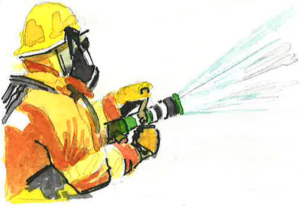
Power plants have used water to generate electricity and gold miners always needed water to pan for gold. Firefighters use water to put out fires. When the water level in the creeks is lower, at the end of the summer, kids have fun tubing down and playing in shallower, calmer areas in the creeks. What do you use water for? Could you live without it?
What is Fast Water and Slow Water?
When creeks rush fast, water gets from the mountain forests down to the plains faster. Farmers, ranchers, and factory owners get it as soon as it melts in the spring. When creeks turn and twist, the water stays in the mountains longer. It forms pools and wetlands — it sinks down into the soil It is easier for insects and animals to drink and bathe in slower-moving water. It is easier for plants to grow in slower water. Slow water means more wildlife, and more plants, too.
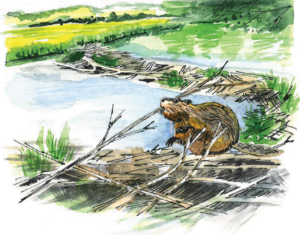
Beavers build dams that slow water down, create more pools and wetlands. People in our county are starting to help beavers come back for this reason. Most of the water still seeps down to the plains, it just does it slower, and some trickles down through the ground as well as in the creek above ground. There is still plenty of fast water for kayakers and farms. And these well-watered areas most often stay green and healthy, even during a big forest fire. Wildlife and plants in these well-watered areas are safe — they don’t burn .
In the mountains, slow water also lets water make its way down, down through the ground, to replenish underground water storage areas called aquifers. These are natural, not made by humans. Aquifers can be really big or small, where water pools in spaces between underground rocks. Often that water is very clean. Storing water underground means it will not evaporate in our dry climate.
Slower Water
Slower water, which flows downhill through the ground as well as on top of it, also means that there is less chance of flooding — instead of all the water rushing away on the surface, the soil is storing it and the soil is a really big storage area. We do have above-ground, human-made water storage in Boulder County. They look like lakes. They are called reservoirs. But if you compare reservoirs to aquifers worldwide, 100 times more water is stored in the ground of the whole world than in all the world’s rivers and lakes!
What About Floods?
Not very often, but once in a long while, such as in 2013, it rains and rains and rains and the creek has to carry more water than it can hold. It is as if you poured water into a cup that was already full and just kept pouring. That water has to go somewhere. If there is an apartment building by the creek, the flood waters will go there. If there is a nice wide natural area on each side of the creek, the water will go there.
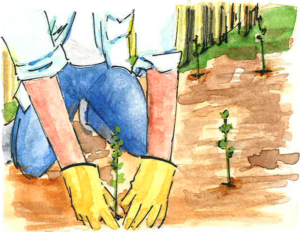 In places where there are a lot of grasses, flowers, bushes, and trees growing on the riverbanks, their roots, stems, and leaves can help suck up the water, which slows flooding down. This helps keep the ground in place.
In places where there are a lot of grasses, flowers, bushes, and trees growing on the riverbanks, their roots, stems, and leaves can help suck up the water, which slows flooding down. This helps keep the ground in place.
In places which are bare dirt or concrete with no or few plants, the water does not get slowed down and its rushing force can uproot the few plants or trees and wash away huge sections of land.
Boulder County knows this and makes sure there are lots of living plants sloping gently right down into to the water on our open spaces where the creeks run, helping to hold the creek banks in place.
Activity: Sculpt a Watershed, Watch the Water!
Ask an older person to assist and play!
To Start
Get a heap of sand and/or clay and/or dirt to sculpt with.
Any of these will do. If you have all of them, you can compare how the water flows and sinks in each. Choose one to start with.
Sculpt a mountain canyon with a creek flowing through it.
- Make some parts of the mountainside steep and some gentle.
- Make parts of the creek bed turn-y and twisty and some straight.
- Make parts of the creek sides (the earth that contains the creeks) steep and some gently sloped.
- Put rocks (pebbles) and pretend bushes on some parts but not others.
- Make a beaver dam right on the creek bed.
Things you can add:
- A road or a path alongside the creek, like the roads and paths along the creeks in the canyons in our county.
- Pine tree and other sturdy twigs in your canyon to make it look like a pine forest.
- Rocks around, in, and near the creek.
- Tiny play figures to be kayakers or people on the paths, or maybe put some houses near the creek.
Now, take a watering can, fill it, and gently rain down some rain onto your mountainside and creek. Then make it rain harder . . . then a little harder . . .
How does the water flow differently down the mountain and in the creek when the mountainside is steep? When it is gentle? When the creek bed is straight and narrow? When straight and wide? Turn-y and twisty? With a beaver dam or tree blocking the creek or part of it? When the banks of the creek are steep? When they are gently sloped?
How fast or slowly does the water sink into the mountainside when it is made of sand? Of clay? Of dirt? When there are rocks around the creek? When there are trees near the creek or far away?
Play with the force of water — make it fast, as a kayak racer would like, or slow, as a beaver would. Re-sculpt the landscape and see: what happens when the water is fast? When it is slow?
Have fun! Take a walk by one of our creeks before and after. Share what you learn with family or friends!
Nature Detectives Library
Every past issue of Nature Detectives can be found in the Nature Detectives Library!


